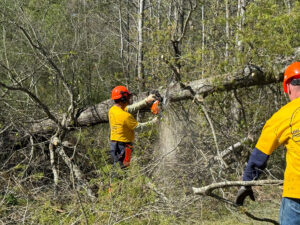The story is told of a man horseback riding one day when he happened upon a group of soldiers attempting to move a heavy piece of timber. With each attempt, they failed. The timber was too much for the men.
There was another man on the scene a corporal, barking orders to heave and roll the large and heavy timber. The man on horseback asked, “Why aren’t you helping them?” The man retorted, “Me? Why I’m a corporal, sir.” Some versions add, “If you want, why don’t you help them?”
The rider dismounted walked over joined the men and moved the timber in place. Before leaving he turned to the men with whom he had co-labored and said, “The next time you need assistance, send for me, your Commander in Chief.” The man on horseback was George Washington.
I have often wondered what that corporal was feeling and thinking as Washington rode away. Certainly, there was a great lesson to be learned that day about leadership. Not only servant leadership, but higher-level leadership. Over and over again in his life, George Washington demonstrated integrity and other traits of higher-level leaders. While every leader aspires to be a higher-level leader, few ever make it.
Whether you have studied five, seven, or even ten levels of leadership, most leaders settle in at one of the two lower levels of leadership. I concur with the five levels of leadership and realize very few men or women ever reach level five. I work quite consistently with pastors and other church and denomination leaders. I have also served in the corporate world and have studied and observed leaders throughout my teen and adult life.
Most pastors (and many other leaders) reside at level one or two for their entire career though they believe themselves to be higher-level leaders. Level one is known as positional leadership. Like the corporal in the above story, level one leaders lead from their position which they assume gives them authority to “bark orders” and command others to obey. Level one leaders never gain the respect of their reports and constituents.
Level two leaders in the church operate in the permission arena. These leaders will never take their church (organization) beyond where they (the leader) believe the church will allow. A pastor once asked me, “George, why are we stuck here? We’ve done…” and he named three to four outside resources and processes the church had undertaken. He listed events and activities. Yet, the church had plateaued and declined for several years.
At the very moment, he was sharing this with me in front of some of his church members, it occurred to me. The reason was not about processes, events, and activities. The real reason was, this pastor, like many others I have worked and interacted with over the years is permissional leaders, not willing to risk moving to higher levels of leadership. Not willing to risk losing members or drawing conflict.
Moving to higher-level leadership is linked to building other leaders. Before you can bring others along into higher levels of leadership, we must first be willing to be built into higher-level leaders ourselves. What will you do today to commit to learning and building yourself into a higher-level leader? Whom can you ask to lead, coach and guide you to greater heights in leadership?







 by
by